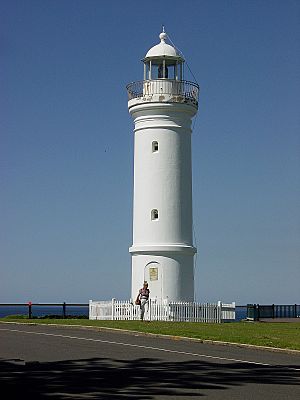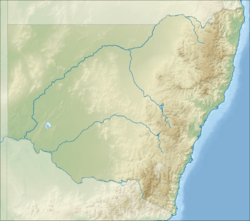Kiama Light facts for kids
 |
|
| Kiama Light | |
|
|
|
| Location | Kiama New South Wales Australia |
|---|---|
| Coordinates | 34°40′18.58″S 150°51′45.47″E / 34.6718278°S 150.8626306°E |
| Year first constructed | 1887 |
| Automated | 1920 |
| Foundation | concrete base |
| Construction | concrete-clad brick tower |
| Tower shape | cylindrical tower with balcony and lantern |
| Markings / pattern | white tower and lantern |
| Height | 51 feet (16 m) |
| Focal height | 119 feet (36 m) |
| Original lens | 4th order Chance Brothers lens |
| Intensity | 28,000 cd |
| Range | 16 nautical miles (30 km; 18 mi) |
| Characteristic | Fl (4) W 20s. |
| Admiralty number | K2598 |
| NGA number | 111-6496 |
| ARLHS number | AUS-236 |
The Kiama Light, also known as the Kiama Harbour Light, is a working lighthouse in Kiama, New South Wales, Australia. You can find it near the famous Kiama Blowhole, on Blowhole Point. It stands just south of Kiama Harbour.
Contents
The Story of Kiama Light
The idea to build the lighthouse came about in 1886. This was ten years after the Robertson Basin, a man-made harbour, opened in Kiama. The lighthouse officially began working on January 1, 1887. A clever engineer named Edward Orpen Moriarty designed it.
When it first started, the light used an oil burner. It had a special lens that made the light fixed, meaning it didn't flash. The light was green and could be seen from about 9 nmi away. Two houses were built nearby. One was for the main lighthouse keeper, and the other was for the assistant keeper.
In 1908, the lighthouse got an upgrade. It started using coal gas for power. This made the light much brighter and it could be seen from 15 nmi away.
By 1913, reports said the light was not watched by a keeper. The keeper's house was empty. The lighthouse officially became automated in 1920. This meant it could run by itself without a keeper. It was upgraded to use acetylene gas and its light changed to a flashing pattern.
Sadly, the main keeper's house was destroyed after the lighthouse became automated. However, the assistant keeper's house remained. It was used for many years by the harbour pilots. Today, this old cottage is a museum and a tourist information centre.
In 1969, the light was updated again. It was connected to mains electricity, which is the power from the grid. It also had a battery backup in case the power went out. The light used today is a powerful quartz halogen lamp.
How the Lighthouse is Built
The lighthouse stands on a strong concrete base. This base is 14 feet deep and 12 feet wide.
The tower itself is made of bricks. The outside is covered in cement, and the inside is plastered smooth. To get to the top, you climb three iron ladders. These ladders lead from one floor to the next. The very top of the lighthouse has a fancy railing around it.
A hexagonal fence surrounds the tower at its base.
Who Manages Kiama Light
The Roads and Maritime Services (which used to be called NSW Maritime) looks after the lighthouse. The museum in the old keeper's cottage is managed by the Kiama Historical Society.
Visiting Kiama Light
You can easily get to the lighthouse by road, and there is parking available. The museum is open on weekends. However, the lighthouse tower itself is not open to the public.



